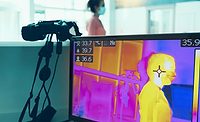The spread of COVID-19 worldwide has dealt a blow to retail. Brick-and-mortar stores will undoubtedly struggle to regain footing in an evolving omnichannel marketplace where retailers are balancing e-commerce, in-store and click-and-pickup shopping options. Beyond the essential functions of security monitoring and recording, IP video surveillance offers myriad video analytic behaviors that can help retail businesses during the ongoing coronavirus pandemic.
Online or in-store, it’s all multichannel for retailers. Before the outbreak, nearly 90 percent of shopping happened in stores while online purchases made up only about 10 percent of all industry-wide retail sales, according to the National Retail Federation. Nine of the top 10 online retailers in the U.S. also operate brick-and-mortar stores.
But that sales ratio has shifted dramatically over the last few months. After the coronavirus hit, orders placed online for pick-up at stores surged 208 percent in April as compared to a year ago, according to Adobe Analytics. The data measured the web transactions of 80 of the top 100 internet retailers in the United States. Retail’s future may depend on how well brick-and-mortar stores can adjust to and coexist with their online counterparts during the ongoing pandemic.
“The lines between the physical shopping experience and the benefits of the digital world are converging rapidly out of necessity, creating an entirely new retail experience based on safety and convenience,” said Jeremy Scott, National Sales Manager for North America at Milestone Systems.
With an open platform video management system (VMS), retailers can use digital tools to quickly pivot to create a solution within the framework of their existing security installation. An open platform enables the integration of compatible video management applications and devices needed for safely operating retail stores, including people counting, access control, social distancing detection, queue management and one-way routes within the store. Retailers can also use these technologies to gather actionable data to enhance the customer experience and improve safety.
People counting, access control and social distancing
Using video analytics driven by machine learning, retailers can track the number of shoppers in their store. With real-time video analysis—which counts people—the retailer is automatically notified when the maximum number of people has been reached. Appropriate measures are set up in advance, helping a store avoid overcrowding or excessive numbers of shoppers.
Video management systems can also be set up with a “one in, one out” policy to control access. Waiting shoppers are notified when they are allowed to enter a store via a “traffic light” device, for example. With this technology, a retailer prevents overcrowding without having to place an employee at the entrance. This prevents both the employee and the customer from being at a greater risk of infection.
Social distancing is becoming the new norm for shoppers. Video technology can detect when people overstep the prescribed safe distance, such as when they are looking at products and suddenly find themselves very close to another person. The video system can immediately set off an alarm, helping remind shoppers to keep a safe distance either by automated cues or personally by an employee.
Queue management
Active queue management is essential. Shorter wait times in the checkout line generally equate to a safer in-store customer experience. Integrating with the VMS, video content analysis tracks how long specific shoppers have waited in line. Based on the store’s wait time policy, real-time alerts are sent to store management to quickly deploy additional cashiers. By continuously monitoring cash registers, a retailer can properly identify customer flows and call in more staff to address the busiest spots in a timely manner. Having better information at hand reduces frustration for time-conscious shoppers, and enables retailers to make better use of available staff resources.
One-way routes
To prevent close contact or traffic jams in a limited space, retailers can guide shoppers through their sales floor on defined “one-way routes”. These prescribed routes only make sense if shoppers adhere to them. Modern video management systems detect when people are moving against the prescribed walking direction and can, for example, trigger an acoustic signal via the loudspeaker to remind shoppers of the correct walking route.
Beyond the core functions of security monitoring and recording, an open platform video management system can help retail businesses further their business outcomes. From using people counting to access control, video management systems hold a wealth of hidden potential to keep staff and shoppers safe. IP video also helps retailers capture and understand valuable business data such as footfall, shopper movement, performance benchmarks, as well as product attraction and conversion.




